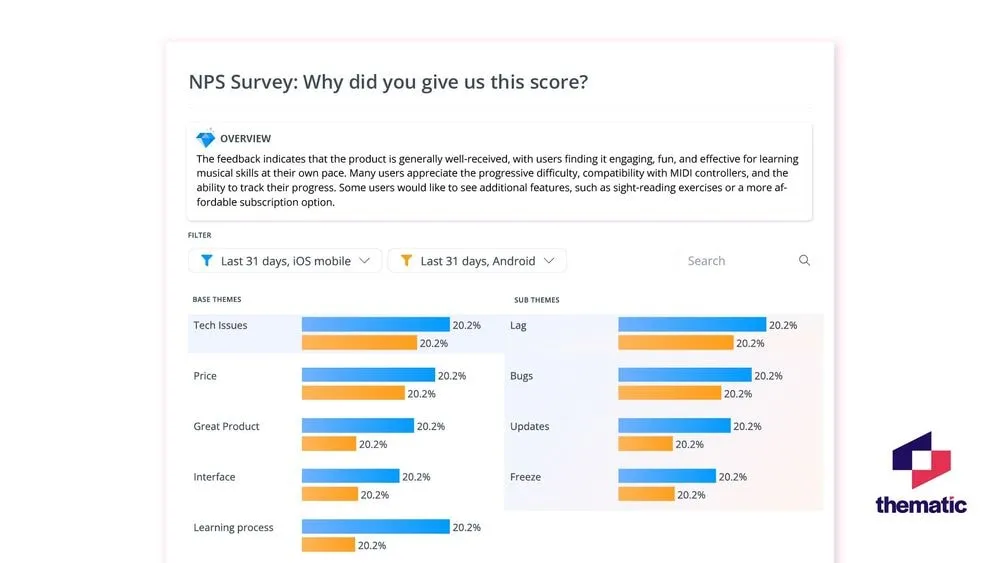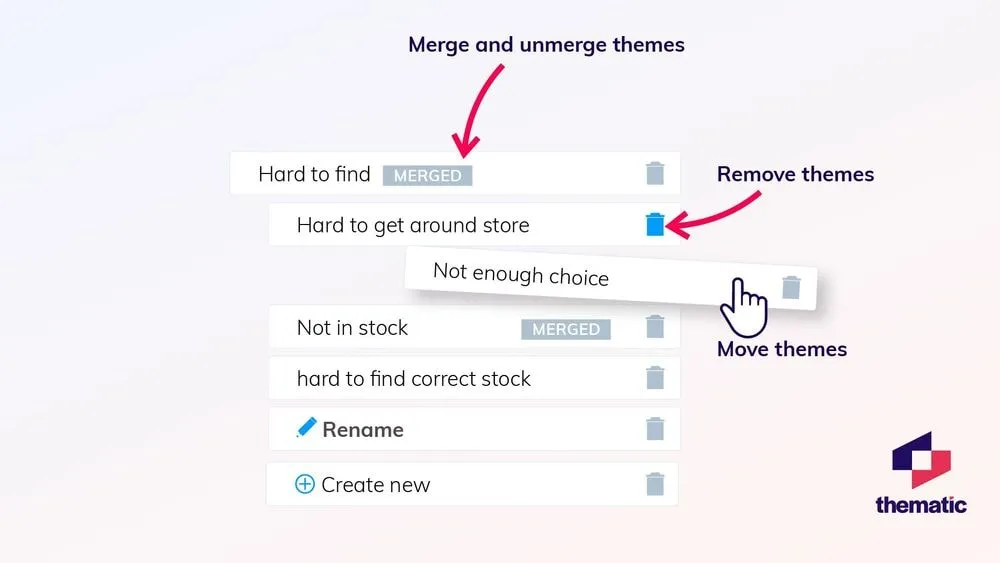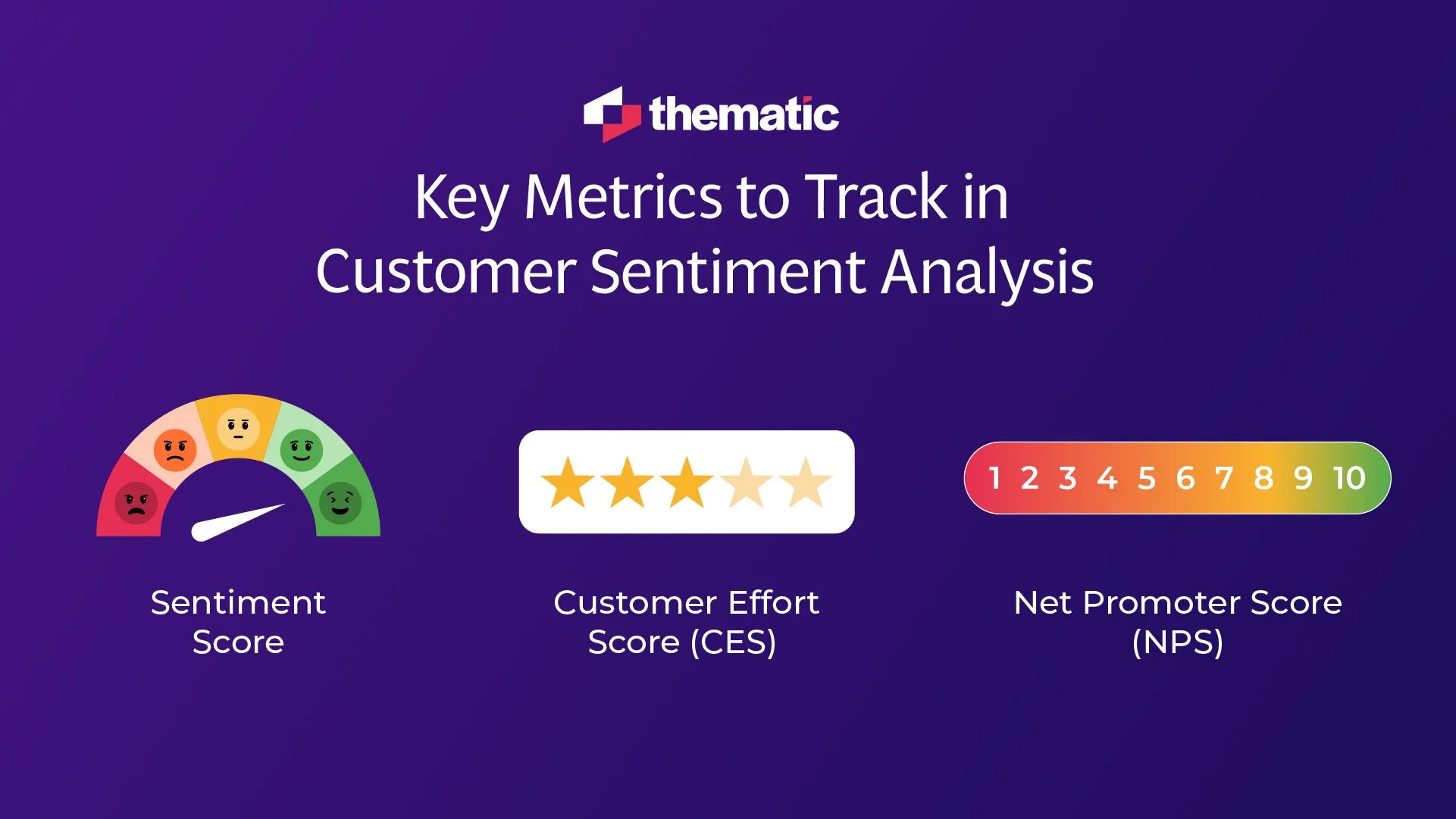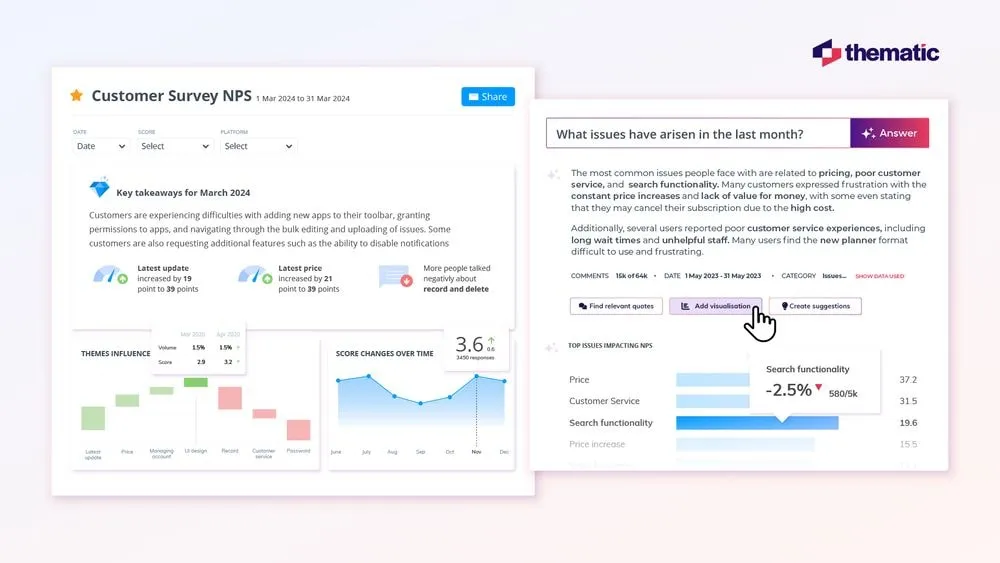
Explore how customer sentiment analysis works and the steps and strategies you need to follow to get started.

Would you rather have a customer who complains or one who quietly leaves?
Most businesses focus on fixing negative reviews, but the real danger lies in the silent, dissatisfied customers who never return. Understanding customer sentiment—how people truly feel about your brand—is the key to keeping them engaged, loyal, and satisfied.
Customer sentiment tells you whether customers are happy, frustrated, or indifferent. Tapping into these emotions helps businesses improve products, enhance experiences, and strengthen brand loyalty. But knowing how to analyze and act on sentiment is where many companies struggle.
Despite 87% of businesses recognizing that data-driven customer experience is a competitive advantage, only 26% actually use analytics to improve their products and services. That means missed opportunities to fix pain points before customers churn.
In this guide, we’ll break down how to analyze customer sentiment effectively using AI, key metrics, and proven strategies. More importantly, we’ll show you how to turn insights into action—so you can keep customers happy and your business thriving.
Customer sentiment refers to the feelings, emotions and attitudes customers have about a particular organization or their products and services. When customers voice opinions about a brand on social media, in online reviews, or customer support interactions, these are all potential sources of customer sentiment data.
In a workshop about deep learning for sentiment analysis we once had led, we realized that customer feedback analysis is one of the hardest NLP tasks. But that shouldn't stop us from figuring out customer sentiments.
Customer sentiment analysis is the process of determining the emotional tone of textual data. The goal is to classify the sentiment of the text as positive, negative, neutral, or on a more granular scale. This allows you to better understand your customers’ attitude and emotions towards your organization.
Text analysis is crucial for understanding and tracking customer sentiment. Text analysis is used to process and categorize written feedback from social media posts, online reviews, or survey responses.
Traditionally this was done by creating a series of rules to categorize the data and designate the sentiment as positive, negative, or neutral.
AI-driven tools like Thematic are useful for customer sentiment analysis since they enable you to analyze huge quantities of data accurately and efficiently. Thematic uses a hybrid approach that combines large language models (LLMs) such as ChatGPT4 with our own algorithms. The platform uses Generative AI for tasks like identifying similar themes or topics in your data and generating summaries.
Advanced AI like Large Language Models (LLMs) are great at understanding complex language, including sarcasm, jokes, and slang. You simply need to enter a prompt and the LLM will categorize the sentiment in your data.
Below you can see our sentiment analysis test using Open AI’s ChatGPT-4. In this test the LLM was 100% accurate compared to just 30% accuracy for the more traditional rule-based method of sentiment analysis.

Organizations need to understand customer sentiment to keep up with ever-evolving customer expectations and outpace competitors. Let’s take a closer look at how customer sentiment data can make a difference.
Customer expectations are always changing and shifting. It’s no longer enough just to be average. Customers expect attentive customer service, good products and services, and a great experience at every stage of the customer journey. And they also want to feel valued as individuals.
According to McKinsey research, 71% of customers now expect companies to personalize their interactions. Analyzing your customer sentiment can help with this by revealing customer pain points, desires, and expectations. For example, sentiment analysis can tell you how strongly they feel about a customer service issue or product feature. Once you understand what’s most important to your customer, you can tailor experiences to match their needs.
Understanding how your customers feel also helps you build brand loyalty and boost customer retention. In one survey 43% of customers left a brand they were loyal to after a poor experience. Keeping on top of how your customers feel helps you to intervene quickly when things go wrong.
For example, you could use customer sentiment analysis to monitor in real-time for issues that significantly impact sentiment scores. When these issues occur your customer service team can be alerted automatically. They can act fast to address the issue and keep the customer happy.
Knowing how customers feel about your competitors is another reason why you should do customer sentiment analysis. It’s a useful way to find out what customers like and don’t like about their brand. And once you have this information you can identify gaps in the market and areas where you can stand out.

Now we know why customer sentiment matters, let’s explore how you actually do it. Customer sentiment analysis typically involves three main steps: data gathering, data analysis using AI tools, and identifying and using your insights.
1. Data Gathering
The first step is to collect your customer feedback from sources like social media, online reviews, emails, and other customer interactions. The type of feedback you collect will depend on what you’re looking to achieve. Gathering data from a range of sources and channels will help give you a comprehensive look into how your customers feel.
2. AI-Powered Customer Sentiment Analysis
Once your data has been gathered and collated, you can start analyzing it with AI-powered tools like Thematic. This text analysis software uses LLMs (Large Language Models) to analyze the sentiment in your data and present it in an accessible format.
For example, Thematic works by breaking down your data into themes using thematic analysis. Sentiment analysis can then be applied to understand how customers feel about each theme and sub-theme.

3. Derive Insights and Take Action
The final step is to actually take action on your insights. Once you’ve analyzed what your customers feel about particular topics, you can use this data to drive your decisions. This could translate into product innovation, rethinking customer interactions, or refining your business strategy.
Traditionally Machine Learning models have been trained to detect complex patterns, making them valuable for more nuanced sentiment interpretation.
AI text analytics has now evolved with the advent of LLMs (Large Language Models). These are more accurate when it comes to sentiment analysis since they’re better at understanding sarcasm, context, and other subtleties in customer language. These models help provide sentiment insights that are closer to human understanding.
AI can be supplemented by a human touch for the best results. For example, AI analytics tool Thematic enables you to make manual tweaks to your analysis. As you can see below, you can use the Themes Editor to delete, edit, merge or create new themes. This can be useful, for example, if you have themes which are not relevant to your organization.

Customer sentiment analysis allows businesses to understand how their customers feel in real-time. That means you can respond and tackle issues as soon as they emerge. For example, your analysis might pick up frequent complaints about long response times. Fixing this issue by employing more customer support staff or streamlining the reporting process will improve customer satisfaction.
When customers are happy and feel valued, they are more likely to stick with your brand. You can use customer sentiment analysis to pick up on what your customers do and don’t like. This will tell you what you need to do to make your customers happier. And ultimately this will increase the likelihood of repeat purchases and positive referrals.
Customer sentiment insights aren’t just useful for improving customer service interactions or creating new products. Almost every area of your organization can benefit from understanding your customers better. For example, marketing teams can use them to hone and personalize their campaigns for particular customer segments. Sales teams might use them to anticipate objections and adapt their strategy accordingly.

Sentiment Score
The customer sentiment score is a numerical rating that expresses the overall sentiment in a particular text, word or phrase. For example, this score could be a number between -100 and 100 with 0 representing neutral sentiment.
Customer sentiment scores are useful because they give a quick snapshot of how your customers feel. You can monitor sentiment scores over time to identify trends, pick up on emerging issues, and gauge how customers have responded to your changes.
Customer Effort Score (CES)
Customer Effort Score expresses how hard or easy it is for customers to interact with an organization. This metric was created by CEB, which is now part of consultancy Gartner. You can measure CES by asking survey questions like how easy it was to resolve an issue on a scale of 1-7. Lower CES scores mean an easier experience, and usually more positive customer sentiment.
CES is then based on the percentage of customers who answer with a 5 or above, indicating they at least somewhat agree. According to Gartner, “There’s a much bigger opportunity to build loyalty if customers can move out of active disagreement or neutral territory.”
Net Promoter Score (NPS)
Net Promoter Score is a popular metric used to assess customer loyalty. The score works by asking customers to rate how likely they’d be to recommend a company or product/service on a scale of 0 to 10. “Ratings of 9 or 10 indicate promoters; 7 and 8, passives; and 0 through 6, detractors. The Net Promoter Score is simply the percentage of promoters minus the percentage of detractors,” according to NPS creators Bain & Company.
Different types of customer feedback give you different types of insights. Before we dive deeper into how to do customer sentiment analysis, let’s cover what you need to be aware of when it comes to selecting and gathering your customer data.
The most direct way to gather feedback is simply to ask your customers what they think. You can use surveys and feedback forms to ask customers specific questions. For example, you might send out a feedback form or survey after a customer service interaction to ask about their experience. You could include quantitative ratings of their experience as well as open-ended questions to get more detail.
Surveys are especially useful if you’re looking to gather data on a specific topic or at a particular point of the customer journey. But bear in mind that survey responses can elicit more formal and filtered responses than other types of feedback.
Customers who’ve had a great or a terrible experience love to vent on social media and online reviews. This can make these platforms a great source of spontaneous and unfiltered customer sentiment. By tracking mentions, comments, and reviews in real-time you can gauge customer sentiment towards your brand at any moment. It can be a useful tool to protect and manage your brand reputation and keep on top of any emerging issues.
Most organizations will have valuable insights tucked away in their customer support tickets, chat logs, and call transcripts. You can dive deeper into these interactions with AI-powered analytics tools and understand exactly what makes your customers frustrated or dissatisfied.
Customer sentiment analysis using analytics tools typically involves the following steps:
Step 1: Gathering and Preparing Customer Data
Customer sentiment analysis requires a little pre-planning. First you’ll need to select the data that’s relevant to your business goals and gather any additional data you might need. Options include sending out specific surveys or pulling data from online review sites like Trustpilot. Think about what you want to know from your customers and the best way to get that data.
The next stage is to prepare your data so it can be analyzed. Raw social media or review data might contain hashtags, links, mentions, or emojis. This type of data needs to be preprocessed to ensure accurate sentiment analysis. These days this is usually done automatically by AI sentiment analysis tools.
Step 2: Using AI and Tools for Customer Sentiment Analysis
AI-powered tools are the best choice if you want accurate insights from complex data sets. Advanced analytics solutions like Thematic use large language models (LLMs) such as GPT4 with their own algorithms. Thematic uses sentiment analysis with thematic analysis to help you understand the emotion behind a theme. Sentiment analysis scores each piece of text or theme and assigns positive, neutral or negative sentiment.

In the example above you can see how Thematic combines both thematic analysis and sentiment analysis to give you deeper insights. You can see exactly how many negative, positive and neutral mentions there are of this particular theme. This allows you to gauge the overall customer sentiment linked to this topic.
Step 3: Interpreting Results
Insights are only as valuable as the action you take on them. How you interpret your results is crucial if you want them to make a real contribution to your organization.
For example, you might want to begin by taking in the big-picture view. How do customers view your brand? From there you can drill down deeper and see which topics are most associated with negative sentiment.
This data can then guide your efforts to improve customer satisfaction or produce better products. Regular reviews of how customer sentiment changes over time can tell you whether you’re on the right track or if you need to go back to the data.
The last part of this process is to make sure the insights go where they’re needed. Thematic offers clear data visualizations that can be shared across your organization to summarize your findings. You can easily drill down into your customer feedback data to see exactly what the problem is, and share this information with the right people in your organization.

Let’s take a closer look at how you can use customer sentiment analysis to make things better for your customers.
Sentiment analysis can tell you what your customers are unhappy about and just how unhappy they are. For example, analyzing social media data might reveal issues that you weren’t aware of. And scouring online reviews could show you what people like and don’t like about specific product features. You could also analyze your competitors to identify any issues they haven’t addressed where you could outperform them.
Understanding your customers better also enhances your support, communication, and marketing and sales strategies. For example, your sentiment analysis might show that customers prefer more personalized interactions. You could then act on this by changing your customer service scripts and communications accordingly.
Customer insights are invaluable for creating and improving products and services so they actually give your customers what they want. For example, you might discover high demand for specific new features or regular complaints about an aspect of your service. You can use these insights to align better with your customers’ needs and make them feel like you are actually listening and responding to what they say.
AI-powered tools have made it easier than ever to analyze customer sentiment. But there are still challenges that you need to be aware of when you’re looking at your own data.
Traditionally analytics tools have struggled to identify and interpret things like sarcasm, mixed sentiments, and slang. Human language is complex, and it’s taken a while for AI tools to adapt. For example, we know the phrase “I love waiting on the phone for hours” is most likely sarcastic. But older rule-based methods of sentiment analysis may have incorrectly categorized the statement as positive due to the word “love”.
These days LLMs like Chat-GPT are very good at interpreting sentiment, as we showed earlier in this article. But they also require careful prompt engineering, are too slow for some applications, and can get costly.
Sensitive customer data needs to be handled appropriately. Customers are increasingly aware and concerned about how their data is being stored and used. As well as being transparent with customers, organizations also need to stay on top of data privacy regulations that apply where they operate. For example, GDPR in Europe and CCPA in California impose strict limitations on data storage and handling.
Customer feedback usually comes in all different shapes and sizes. Social media, online reviews, support tickets, and surveys each have their own characteristics. Instagram posts might use lots of slang, abbreviations, and humour, while surveys often generate more formal language. This can make it hard to analyze customer sentiment consistently across all your data. Ideally, you should look for a comprehensive analytics tool like Thematic that can handle all your data in one place.
AI sentiment analysis tools have made it easier and faster than ever before to track customer sentiment and get actionable insights. You can monitor an urgent issue in real-time as it emerges and get it fixed fast. These instant feedback loops allow you to keep your customers happy and minimize the negative impact of issues and complaints.
The next step is to go one step ahead of your customers. Predictive insights allow businesses to anticipate customer needs and preferences before they voice them. This way you can take action before something even becomes an issue.
As we mentioned at the start of this guide, the vast majority of organizations know how important tracking customer sentiment is for staying competitive. Yet only a fraction are currently doing it. The biggest issue facing many organizations seems to be simply getting started with customer sentiment analytics. Fortunately, AI-powered solutions like Thematic make it easy even for non-technical teams thanks to simple integrations and accessible visualizations and data manipulation.
Ready to try customer sentiment analysis on your own data? Why not start right here with a free guided demo of Thematic using your data.
Join the newsletter to receive the latest updates in your inbox.